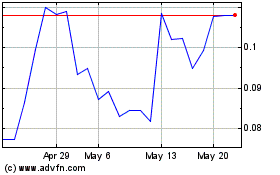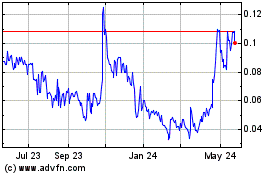US NUCLEAR PARTNER GRAPHETON'S PATENTED NEW "GLASSY CARBON" MICRO SUPER CAPACITOR SHOWS PROMISE AS NEXT GENERATION MICROCHIP
19 April 2021 - 10:30PM
InvestorsHub NewsWire
Canoga Park, CA -- April 19, 2021 -- InvestorsHub
NewsWire
- $513B
Semiconductor Industry is stalled with shortages and needs
innovation for America to regain its
leadership
- Biden
proposing $50B to help remedy shortages and inspire
innovation
- Capacitors used for storing energy
are essential components on IC boards but are too big to be placed
on a microchip or are inadequate when they are downsized as a micro
capacitor to fit on a chip
- US
Nuclear/Grapheton claim their patented new “Glassy Carbon” micro
super capacitor can fit on a microchip and can be several orders of
magnitude more powerful than micro capacitors currently used in
cellphones and other devices
- Replacing clunky capacitors from
IC boards to microchips allows for further miniaturization for
smaller and more powerful circuit boards and also avoids energy
transmission loss
- Each
mobile phone has about 300 to 400 capacitors, each smartphone about
400 to 500, and each notebook computer or tablet device about 700
to 800 in each device
- Grapheton believes next generation
microchips with “Glassy Carbon” micro super capacitors can replace
current capacitor technology and can be rapidly put into production
since they can be built right into chips by existing
factories
- Grapheton is private company. US
Nuclear owns 40% of Grapheton and has market cap of only $15
million with share price about $.60
The current
microchip shortage caught the world by surprise and is causing
shockwaves such as temporary closings of several large automobile.
manufacturing facilities. The shortages won’t last forever but have
nonetheless attracted investor’s attention to microchips and
created a new focus on sustained manufacturing practices with a
strong emphasis on innovation so America can regain its leadership
in the crucial tech sector.
Never has
the semiconductor or “chip” sector been more competitive, with more
than 750 companies vying globally to build the insides of
cellphones or the next hot device or power future mega computers.
Investors may find it tricky to navigate this sector, but this
major new opportunity recently announced by US Nuclear Corp.
(UCLE:
OTC) could become red hot.
The basic
building blocks of electric circuits have always been the same . .
. diodes, transistors, resistors, capacitors, transformers and
wires. Most of these components have been miniaturized and
duplicated on a tiny microchip but capacitors remain a problem.
They have just been too big to put on a chip and are usually placed
on the larger circuit board. There have been a few micro
capacitors, but their storage capacity is almost useless. But now
with the US Nuclear/Grapheton “Glassy Carbon” Super Capacitor
MicroChip, there appears to be a breakthrough that could put
America back on top in terms of innovation.
THIS GRAPHETON “GLASSY
CARBON” MICRO SUPER CAPACITOR (BELOW) IS FOR HUMAN WEARABLE
APPLICATIONS BUT IT IS EVEN MUCH SMALLER IN IC BOARD CHIPS AND IS
USEFUL IN MOST MICROCHIPS FOR ALMOST EVERY
APPLICATION

EXAMPLE OF MACRO SIZE
GLASSY CARBON CAPACITOR

US
Nuclear Corp Announces New “Glassy Carbon” Super Capacitor
MicroChip
US Nuclear’s
Grapheton “Glassy Carbon” Super Capacitor MicroChip is believed to
be a major breakthrough in chip evolution and with micro capacitors
that can be more powerful than today’s clunky off-chip capacitors
and several orders of magnitude more powerful than the micro
versions now in use that have very little storage
capacity.
From
Big Circuit Boards to Tiny IC Chips
The new
“Glassy Carbon” super capacitor microchip appears to have the
potential to make circuit boards that can be miniaturized even
further thereby opening the door to smaller and smaller cell phones
and electronic devices. This could be the major innovative
breakthrough that the industry has been looking
for.
The
breakthrough came about as US Nuclear’s strategic partner Grapheton
was developing a microchip for human body implants that would not
require a battery. Grapheton developed a chip that used the body’s
salinity to provide power for the chip and they also developed the
tiny “Glassy Carbon” Super Capacitor MicroChip that could store
several orders of magnitude more electric energy than current
on-chip capacitors so the chip would never run short of
energy.
After
developing this super capacitor microchip, US Nuclear and Grapheton
realized that it has the potential to be used in all microchips in
cell phones, automobiles, computers, televisions and pretty much
all microchip applications.
FROM THIS
(CONVENTIONAL CLUNKY 3 mF
CAPACITOR)

TO THIS THAT WILL BE
EVEN SMALLER IN MICROCHIPS

Short Milestone Path
Grapheton
CEO, Dr. Sam Kassegne says, “While we are not a chip
manufacturer, we believe it will not take long, perhaps 60 to 90
days, to have a chip manufacturer produce a variety of our first
prototypes that we can use to demonstrate to interested
companies.” Kessegne added, “These
supercapacitors can be swiftly put into production since they can
be built right into the chips as they are being fabricated by
existing chip manufacturing plants.”
Conclusion
The semiconductor industry was
reported at $513 billion in 2019 and projected to reach $726 billion in 2027.
Grapheton is a private company which is 40% owned by US Nuclear. US
Nuclear has a market cap of about $15 million and a share price of
$.58 as of this writing.
Safe Harbor Act and Disclosure:
This press release includes
"forward-looking statements" within the meaning of the safe harbor
provisions of the United States Private Securities Litigation
Reform Act of 1995. Actual results may differ from expectations,
estimates and projections and, consequently, you should not rely on
these forward looking statements as predictions of future events.
Words such as "expect," "estimate," "project," "budget,"
"forecast," "anticipate," "intend," "plan," "may," "will," "could,"
"should," "believes," "predicts," "potential," "continue," and
similar expressions are intended to identify such forward-looking
statements. These forward-looking statements involve significant
risks and uncertainties that could cause the actual results to
differ materially from the expected results. BioResearchAlert was
compensated for this article.
US Nuclear (PK) (USOTC:UCLE)
Historical Stock Chart
From Dec 2024 to Jan 2025

US Nuclear (PK) (USOTC:UCLE)
Historical Stock Chart
From Jan 2024 to Jan 2025
